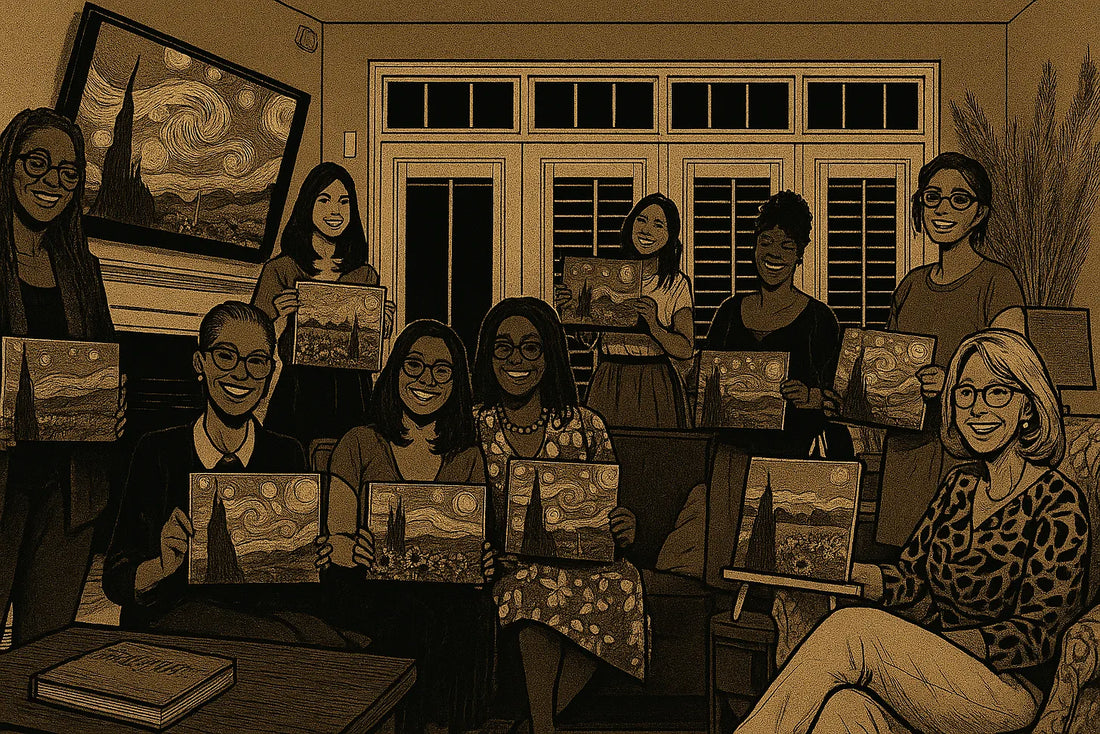
Oh What A 'Starry Night!'
Share
This past weekend I went to a Sip n Paint party with my ladies. A little wine, soulful music playing in the background, GREAT food (our host was a chef at her own restaurant) and some pretty honest discussions about life as a mature. Not talking about husbands, children or ex’s - just chatting about our own wellbeing. How problem solving, through the quality of learned patience helped us to stamp out the bugs in our lives. For some it was through the hope that day follows night (looking at matters through the lens of a new day); for others it involved the existence of a higher power even higher than van Gogh’s enormous tree. How refreshing! Indeed, a starry night of truths and loads of laughter!
We painted, or at least attempted to paint Vincent van Gogh’s ‘The Starry Night.’

Afterwards, we laughed while strategically comparing our paintings. Did the ones who added sunflowers get the commission wrong!

No doubt, even in his state of despair, van Gogh would have been thoroughly amused. Then I pondered, how he would interpret my painting? Exactly how would our conversation go? I imagined our dialogue going something like this:
“Monsieur van Gogh, I’m Brenda. What do you think of my version of The Starry Night?” Asked with every bit of a child’s excitement.
“You may call me Vincent. I believe art is subjective. When I consider a piece, I think carefully about the person doing the painting. Let me think.. you penciled the picture beforehand. Ah, you have a need for precision. A deep thinker, perhaps. I am convinced you have artistic abilities but you are no painter!” A bit of sarcasm in his voice.
“Hmm. You pegged me to a tee! Okay, I gotta share a funny story?”
“Please …”
“Okay, so while I was painting, I had two white cups. The one on my left had water for dipping my brushes. Someone gave me a second white cup with some Margarita in it for tasting. Not wanting to mix them up, I placed the second cup on my right side. Oh, by the way, I’m right handed. Well, I was so busy painting and running my mouth, I didn’t notice that I kept dipping my brushes in the cup with the Margarita! Needless to say, I was painting with some pretty toxic components and spirits!” I laughed and his smile indicated he was pleasantly entertained.
“It would surprise you of the many components we mixed with our paint. It was a struggle to create brilliant colors that created mystery, intrigue and tranquility.”
“Do you think the oil paints and chemicals affected your health?”
Not answering my question, he went into his own dialogue.
“You must understand, the use of color and pigments was crucial to convey emotions and moods.” As if he were teaching a MasterClass, he continued, “I used yellow ochre to create a warm, golden tone for landscapes giving the idea of tranquility and peacefulness. Vermilion! What an addiction - but how else could I create vibrant reds. I was very fond of inserting the deep rich Prussian blue for my night scenes.”
“Were there dangers? It was a paradox. Imagine being hijacked by your craft. It was a time of tension, a fight against time,” he drifted off message.“I fought with Gauguin. I had to go away, you know,” a sad admission. “My vision was beyond my grasp,” he lamented.
“Yes, I know. You spent a year in Saint-Paul de Mausole [psychiatric hospital]. I read you painted almost 150 paintings during that time, even Starry Night. I believe the artists ‘ultimate achievement’ is to teach the viewer a visual language that carries meaning beyond its literal appearance (I read that). I fear you wrestled with inner struggles but oddly enough, life in Saint-Paul de Mausole was your most productive period. Ultimately, existence without the reinforcement of hope keeps us from moving forward. I was inspired by your Starry Night painting.”
“You are very perceptive. How were you inspired?”
“Well, as the villagers peacefully prepare for nightfall, they had no fear of weather or beast because the protective tree watched over the community. Tells me two things: I’m drawn to an even higher power than that immense tree; and the hope of a new day always follows the night. And we have the power to shine positivity on that new day.”
“After months of psychotherapy, I hadn’t explored, as you say, a message of Hope. Perhaps I should have been in therapy with You!”
That ended my imaginary convo with van Gogh. There’s something powerful about talking things out and feeling understood.
However, on 27 July 1890, in a field near Auvers, Vincent shot himself in the chest with a revolver. He died two days later, with his brother Theo at his bedside. Why did he choose to end his life? It’s been said he was exhausted from working hard and the high standards he set for himself.
I think he lacked the hope to keep going..
Writing this piece helped me to foster hope (the fuel that keeps us moving forward) with family, friends or people I meet. Through empathy and compassion we cultivate the belief that even in the face of adversity, active support enhances relationships. -B
